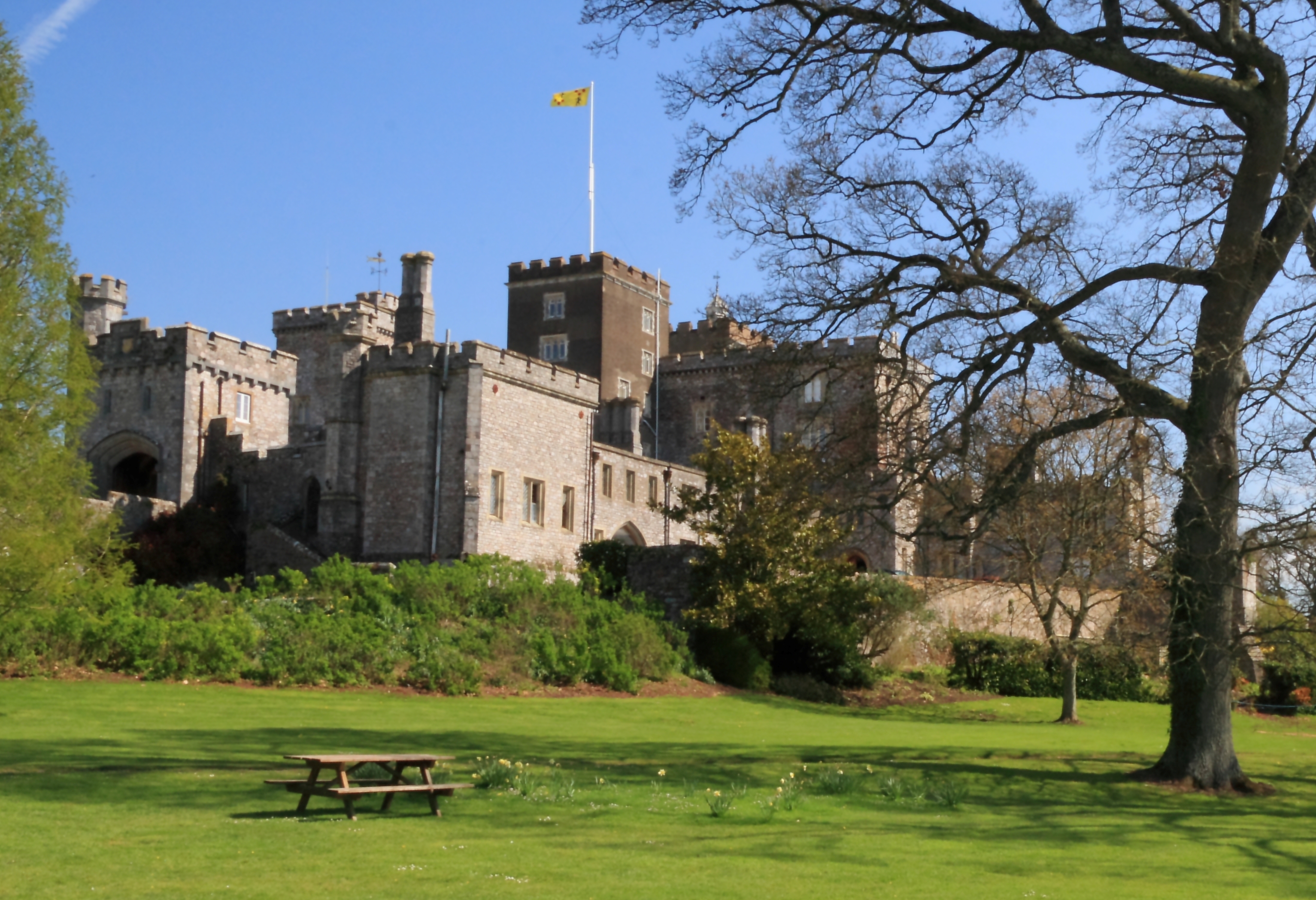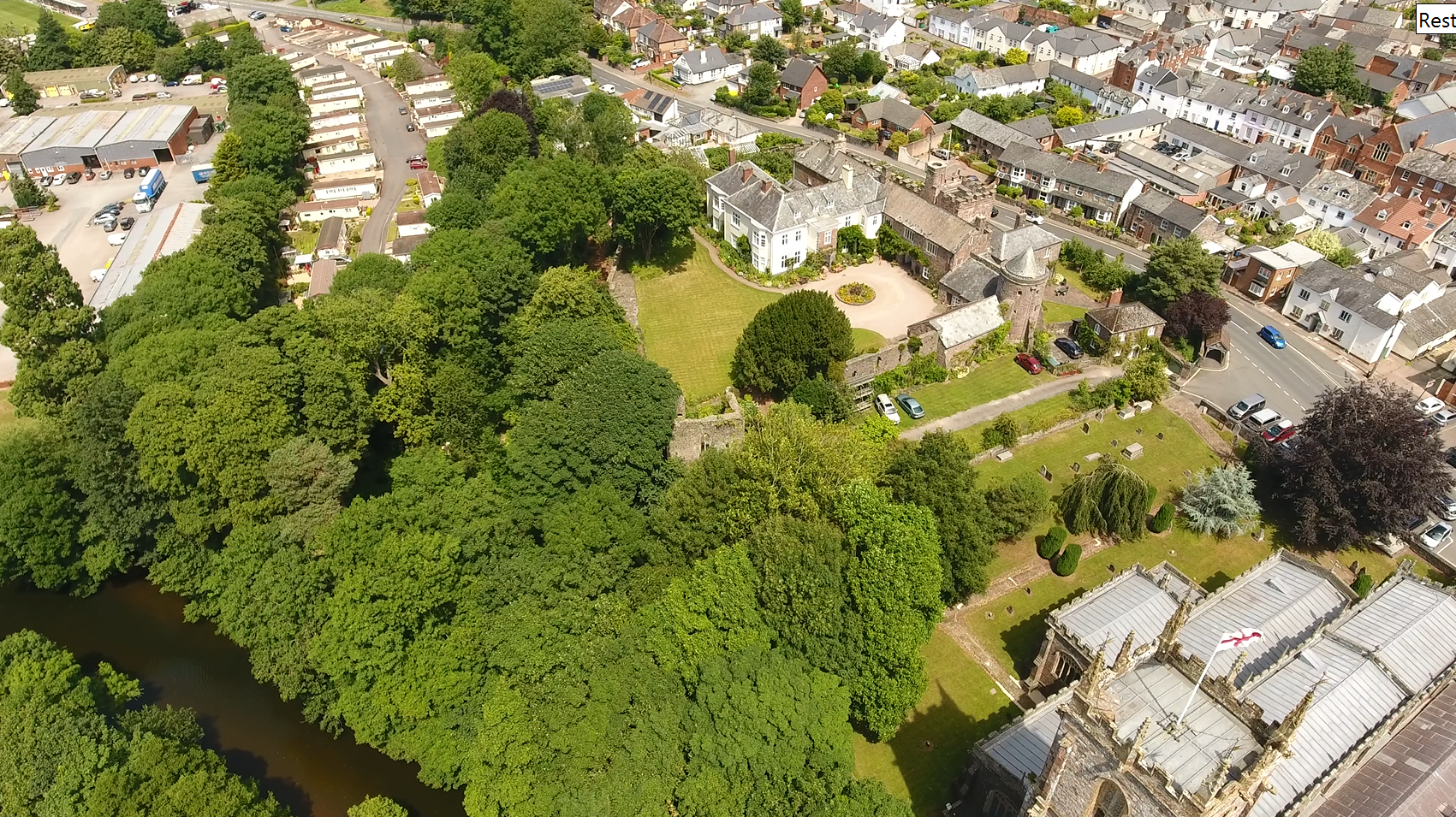|
Manor Of Powderham
Powderham Castle is a fortified manor house situated within the parish and former manor of Powderham, within the former hundred of Exminster, Devon, about south of the city of Exeter and mile (0.4 km) north-east of the village of Kenton, where the main public entrance gates are located. It is a Grade I listed building. The park and gardens are Grade II* listed in the National Register of Historic Parks and Gardens. It is situated on flat, formerly marshy ground on the west bank of the River Exe estuary where it is joined by its tributary the River Kenn. On the opposite side of the Exe is the small village of Lympstone. Starting with a structure built sometime after 1390, the present castle was expanded and altered extensively in the 18th and 19th centuries. The castle remains the seat of the Courtenay family, Earls of Devon. Origin of the name The manor Manor may refer to: Land ownership *Manorialism or "manor system", the method of land ownership (or "t ... [...More Info...] [...Related Items...] OR: [Wikipedia] [Google] [Baidu] |
Courtenay Family
The House of Courtenay is a medieval noble house, with branches in France, England and Crusader states, the Holy Land. One branch of the Capetian House of Courtenay, Courtenays became a Royal House of the Capetian Dynasty, cousins of the House of Bourbon, Bourbons and the House of Valois, Valois, and achieved the title of Latin Emperor of Constantinople, Latin Emperor of Constantinople. Origin The house was founded by Athon, the first lord of Courtenay, Loiret, Courtenay in France. Athon took advantage of the succession crisis in the Duchy of Burgundy between Otto-William, Duke of Burgundy and King Robert II of France to capture a piece of land for himself, where he established his own seigneury (lordship), taking his surname from the town he founded and fortified. Athon was succeeded by his son Joscelin I, Lord of Courtenay, Joscelin, who had three sons: Miles, who was Lord of Courtenay after him; Prince Joscelin I, Count of Edessa, Joscelin, who joined the First Crusade and ... [...More Info...] [...Related Items...] OR: [Wikipedia] [Google] [Baidu] |
Keep
A keep (from the Middle English ''kype'') is a type of fortified tower built within castles during the Middle Ages by European nobility. Scholars have debated the scope of the word ''keep'', but usually consider it to refer to large towers in castles that were fortified residences, used as a refuge of last resort should the rest of the castle fall to an adversary. The first keeps were made of timber and formed a key part of the motte-and-bailey castles that emerged in Normandy and Anjou during the 10th century; the design spread to England, south Italy and Sicily. As a result of the Norman invasion of 1066, use spread into Wales during the second half of the 11th century and into Ireland in the 1170s. The Anglo-Normans and French rulers began to build stone keeps during the 10th and 11th centuries; these included Norman keeps, with a square or rectangular design, and circular shell keeps. Stone keeps carried considerable political as well as military importance and could tak ... [...More Info...] [...Related Items...] OR: [Wikipedia] [Google] [Baidu] |
De Facto
''De facto'' ( ; , "in fact") describes practices that exist in reality, whether or not they are officially recognized by laws or other formal norms. It is commonly used to refer to what happens in practice, in contrast with '' de jure'' ("by law"), which refers to things that happen according to official law, regardless of whether the practice exists in reality. History In jurisprudence, it mainly means "practiced, but not necessarily defined by law" or "practiced or is valid, but not officially established". Basically, this expression is opposed to the concept of "de jure" (which means "as defined by law") when it comes to law, management or technology (such as standards) in the case of creation, development or application of "without" or "against" instructions, but in accordance with "with practice". When legal situations are discussed, "de jure" means "expressed by law", while "de facto" means action or what is practiced. Similar expressions: "essentially", "unofficial", " ... [...More Info...] [...Related Items...] OR: [Wikipedia] [Google] [Baidu] |
De Jure
In law and government, ''de jure'' ( ; , "by law") describes practices that are legally recognized, regardless of whether the practice exists in reality. In contrast, ("in fact") describes situations that exist in reality, even if not legally recognized. Examples Between 1805 and 1914, the ruling dynasty of Egypt were subject to the rulers of the Ottoman Empire, but acted as de facto independent rulers who maintained a polite fiction of Ottoman suzerainty. However, starting from around 1882, the rulers had only de jure rule over Egypt, as it had by then become a British puppet state. Thus, by Ottoman law, Egypt was de jure a province of the Ottoman Empire, but de facto was part of the British Empire. In U.S. law, particularly after '' Brown v. Board of Education'' (1954), the difference between de facto segregation (segregation that existed because of the voluntary associations and neighborhoods) and de jure segregation (segregation that existed because of local laws th ... [...More Info...] [...Related Items...] OR: [Wikipedia] [Google] [Baidu] |
Member Of Parliament
A member of parliament (MP) is the representative in parliament of the people who live in their electoral district. In many countries with Bicameralism, bicameral parliaments, this term refers only to members of the lower house since upper house members often have a different title. The terms Member of Congress, congressman/congresswoman or Deputy (legislator), deputy are equivalent terms used in other jurisdictions. The term parliamentarian (other), parliamentarian is also sometimes used for members of parliament, but this may also be used to refer to unelected government officials with specific roles in a parliament and other expert advisers on parliamentary procedure such as the Senate Parliamentarian in the United States. The term is also used to the characteristic of performing the duties of a member of a legislature, for example: "The two party leaders often disagreed on issues, but both were excellent parliamentarians and cooperated to get many good things done." ... [...More Info...] [...Related Items...] OR: [Wikipedia] [Google] [Baidu] |
Sheriff
A sheriff is a government official, with varying duties, existing in some countries with historical ties to England where the office originated. There is an analogous, although independently developed, office in Iceland that is commonly translated to English as ''sherif''. Description Historically, a sheriff was a legal official with responsibility for a shire, the term being a contraction of "shire reeve" (Old English ). In British English, the political or legal office of a sheriff, term of office of a sheriff, or jurisdiction of a sheriff, is called a shrievalty in England and Wales, and a sheriffdom in Scotland. In modern times, the specific combination of legal, political and ceremonial duties of a sheriff varies greatly from country to country. * In England, Northern Ireland, or Wales, a sheriff (or high sheriff) is a ceremonial county or city official. * In Scotland, sheriffs are judges. * In the Republic of Ireland, in some counties and in the cities of Dublin an ... [...More Info...] [...Related Items...] OR: [Wikipedia] [Google] [Baidu] |
Justice Of The Peace
A justice of the peace (JP) is a judicial officer of a lower or '' puisne'' court, elected or appointed by means of a commission (letters patent) to keep the peace. In past centuries the term commissioner of the peace was often used with the same meaning. Depending on the jurisdiction, such justices dispense summary justice or merely deal with local administrative applications in common law jurisdictions. Justices of the peace are appointed or elected from the citizens of the jurisdiction in which they serve, and are (or were) usually not required to have any formal legal education in order to qualify for the office. Some jurisdictions have varying forms of training for JPs. History In 1195, Richard I ("the Lionheart") of England and his Minister Hubert Walter commissioned certain knights to preserve the peace in unruly areas. They were responsible to the King in ensuring that the law was upheld and preserving the " King's peace". Therefore, they were known as "keepers of th ... [...More Info...] [...Related Items...] OR: [Wikipedia] [Google] [Baidu] |
Tiverton Castle
Tiverton Castle is the remains of a medieval castle dismantled after the Civil War and thereafter converted in the 17th century into a country house. It occupies a defensive position above the banks of the River Exe at Tiverton in Devon. Description Once considerably larger, Tiverton Castle now comprises a group of ruined defensive perimeter walls, towers and buildings from various periods. A Norman motte was built in 1106. History Civil War During the Civil War the Castle was a Royalist stronghold. Fairfax's Parliamentarian troops laid siege to a troop of Royalists within the Castle and set up his headquarters at Blundell's School and stationed his artillery on Skrink Hills (or "Shrink" Hills) just above him and below Cranmore Castle, about half a mile from Tiverton Castle. The Culverin, the largest artillery piece used by the New Model Army, was capable of firing up to 2,000 yards. Whilst they were still finding their range a lucky shot hit one of the chains holdin ... [...More Info...] [...Related Items...] OR: [Wikipedia] [Google] [Baidu] |
Hugh Courtenay, 2nd Earl Of Devon
Sir Hugh de Courtenay, 2nd/10th Earl of Devon (12 July 1303 – 2 May 1377), 2nd Baron Courtenay, feudal baron of Okehampton and feudal baron of Plympton, played an important role in the Hundred Years War in the service of King Edward III. His chief seats were Tiverton Castle and Okehampton Castle in Devon. The ordinal number given to the early Courtenay Earls of Devon depends on whether the earldom is deemed a new creation by the letters patent granted 22 February 1334/5 or whether it is deemed a restitution of the old dignity of the de Redvers family. Authorities differ in their opinions, and thus alternative ordinal numbers exist, given here. Origins Hugh de Courtenay was born on 12 July 1303, the second son of Hugh de Courtenay, 1st/9th Earl of Devon (1276–1340), by his wife Agnes de Saint John, a daughter of Sir John de Saint John of Basing, Hampshire. He succeeded to the earldom on the death of his father in 1340. His elder brother, John de Courtenay (c.1296-11 July ... [...More Info...] [...Related Items...] OR: [Wikipedia] [Google] [Baidu] |
Powderham Castle
Powderham Castle is a fortified manor house situated within the parish and former manor of Powderham, within the former hundred of Exminster, Devon, about south of the city of Exeter and mile (0.4 km) north-east of the village of Kenton, where the main public entrance gates are located. It is a Grade I listed building. The park and gardens are Grade II* listed in the National Register of Historic Parks and Gardens. It is situated on flat, formerly marshy ground on the west bank of the River Exe estuary where it is joined by its tributary the River Kenn. On the opposite side of the Exe is the small village of Lympstone. Starting with a structure built sometime after 1390, the present castle was expanded and altered extensively in the 18th and 19th centuries. The castle remains the seat of the Courtenay family, Earls of Devon. Origin of the name The manor of Powderham is named from the ancient Dutch word polder, and means "the hamlet of the reclaimed marsh- ... [...More Info...] [...Related Items...] OR: [Wikipedia] [Google] [Baidu] |



